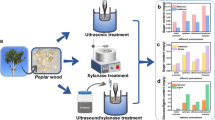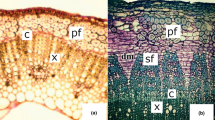Abstract
Thorough understanding of how hemicelluloses removal influences cell wall nanoscale architecture and cellulose digestion is of crucial importance for enabling low-cost industrial conversion of lignocellulosic biomass to renewable biofuels. In this work, delignified poplar cell walls, after various degrees of hemicelluloses removal, were characterized by Fourier transform infrared imaging spectroscopy and atomic force microscopy to evaluate enhancement in cell wall digestibility. There was a gradual decrease in hemicelluloses content with dilute alkali treatment, which resulted in alterations in the nanoscale architecture and crystallinity of cell walls. Removal of hemicelluloses did not disrupt the integrity of microfibrils but resulted in exposure of microfibrils and a decrease in the diameter of microfibrils. X-ray analysis indicated that the increase in crystallinity beyond natural variations in the crystallinity of cellulose was mainly attributable to removal of hemicelluloses. In conclusion, alterations in the architecture and crystallinity of cell walls facilitated enzymatic digestion of delignified poplar, enhancing cellulose conversion from 68.24 to 75.16 %.






Similar content being viewed by others
Abbreviations
- FT-IR microspectroscopy:
-
Fourier transform infrared microspectroscopy
- AFM:
-
Atomic force microscopy
- XRD:
-
X-ray diffraction
- CrI:
-
Crystallinity index
- CCML:
-
Cell corner middle lamella
- CML:
-
Compound middle lamella
- F-S:
-
Fiber secondary wall
- CEF:
-
Cellulose elementary fibril
References
Pauly M, Keegstra K (2008) Cell-wall carbohydrates and their modification as a resource for biofuels. Plant J 54(4):559–568
Sheehan J, Himmel ME (1999) Enzymes, energy, and the environment: cellulase development in the emerging bioethanol industry. Biotechnol Prog 15(3):817–827
Somerville C (2006) The billion-ton biofuels vision
Balat M, Balat H (2009) Recent trends in global production and utilization of bio-ethanol fuel. Appl Energy 86(11):2273–2282
Himmel ME, Ding SY, Johnson DK, Adney WS, Nimlos MR, Brady JW et al (2007) Biomass recalcitrance: engineering plants and enzymes for biofuels production. Science 315(5813):804–807
Ding SY, Liu YS, Zeng YY, Himmel ME, Baker JO, Bayer EA (2012) How does plant cell wall nanoscale architecture correlate with enzymatic digestibility? Science 338(6110):1055–1060
Dien BS, Sarath G, Pedersen JF, Sattler SE, Chen H, Funnell-Harris DL et al (2009) Improved sugar conversion and ethanol yield for forage sorghum (Sorghum bicolor L. Moench) lines with reduced lignin contents. Bioenerg Res 2(3):153–164
Meng XZ, Wells T, Sun QN, Huang F, Ragauskas A (2015) Insights into the effect of dilute acid, hot water or alkaline pretreatment on the cellulose accessible surface area and the overall porosity of Populus. Green Chem 17(8):4239–4246
Ma J, Zhang X, Zhou X, Xu F (2014) Revealing the changes in topochemical characteristics of poplar cell wall during hydrothermal pretreatment. Bioenerg Res 7(4):1358–1368
Leu SY, Zhu JY (2013) Substrate-related factors affecting enzymatic saccharification of lignocelluloses: our recent understanding. Bioenerg Res 6(2):405–415
Zhu JY, Pan XJ, Zalesny RS Jr (2010) Pretreatment of woody biomass for biofuel production: energy efficiency, technologies, and recalcitrance. Appl Microbiol Biotechnol 87(3):847–857
Yang HY, Chen Q, Wang K, Sun RC (2013) Correlation between hemicelluloses-removal induced hydrophilicity variation and the bioconversion efficiency of lignocelluloses. Bioresour Technol 147:539–544
Yang B, Wyman CE (2004) Effect of xylan and lignin removal by batch and flowthrough pretreatment on the enzymatic digestibility of corn stover cellulose. Biotechnol Bioeng 86(1):88–98
Galbe M, Zacchi G (2002) A review of the production of ethanol from softwood. Appl Microbiol Biotechnol 59(6):618–628
Chundawat SP, Venkatesh B, Dale BE (2007) Effect of particle size based separation of milled corn stover on AFEX pretreatment and enzymatic digestibility. Biotechnol Bioeng 96(2):219–231
Buranov AU, Mazza G (2010) Extraction and characterization of hemicelluloses from flax shives by different methods. Carbohydr Polym 79(1):17–25
McCann MC, Chen L, Roberts EK, Kemsley E, Sene C, Carpita NC et al (1997) Infrared microspectroscopy: sampling heterogeneity in plant cell wall composition and architecture. Physiol Plant 100(3):729–738
Himmelsbach DS, Khalili S, Akin DE (2002) The use of FT-IR microspectroscopic mapping to study the effects of enzymatic retting of flax (Linum usitatissimum L) stems. J Sci Food Agric 82(7):685–696
Labbe N, Rials TG, Kelley SS, Cheng ZM, Kim JY, Li Y (2005) FT-IR imaging and pyrolysis-molecular beam mass spectrometry: new tools to investigate wood tissues. Wood Sci Technol 39(1):61–76
Niemi H, Paulapuro H, Mahlberg R (2002) Review: application of scanning probe microscopy to wood, fibre and paper research. Paperi Ja Puu 84(6):389–406
Zhou X, Ma J, Ji Z, Zhang X, Ramaswamy S, Xu F, Sun RC (2014) Dilute acid pretreatment differentially affects the compositional and architectural features of Pinus bungeana Zucc. compression and opposite wood tracheid walls. Ind Crop Prod 62:196–203
Lundqvist J, Teleman A, Junel L, Zacchi G, Dahlman O, Tjerneld F et al (2002) Isolation and characterization of galactoglucomannan from spruce (Picea abies). Carbohydr Polym 48:29–39
Sluiter A, Hames B, Ruiz R, Scarlata C, Sluiter J, Templeton D (2006) Determination of sugars, byproducts, and degradation products in liquid fraction process samples. National Renewable Energy Laboratory, Golden
Donaldson L, Lausberg M (1998) Comparison of conventional transmitted light and confocal microscopy for measuring wood cell dimensions by image analysis. IAWA J 19(3):321–336
Yin YF, Berglund L, Salmén L (2010) Effect of steam treatment on the properties of wood cell walls. Biomacromolecules 12(1):194–202
Ding SY, Himmel ME (2006) The maize primary cell wall microfibril: a new model derived from direct visualization. J Agr Food Chem 54(3):597–606
Segal L, Creely J, Martin A, Conrad C (1959) An empirical method for estimating the degree of crystallinity of native cellulose using the X-ray diffractometer. Text Res J 29(10):786–794
Mirahmadi K, Kabir MM, Jeihanipour A, Karimi K, Taherzadeh M (2010) Alkaline pretreatment of spruce and birch to improve bioethanol and biogas production. BioResources 5(2):928–938
Lai YZ (1991) Wood and cellulosic chemistry: Chemical degradation. Hon DNS and Shiraishi N (Eds) New York: Marcel Dekker Inc; pp 455–473
Kutscha N, McOrmond R (1972) The suitability fo using fluorescence microscopy for studying lignification in Balsam Fir Tech. Bull Life Sci Agr Exp Sta Univ Maine 62:15
Donaldson L, Hague J, Snell R (2001) Lignin distribution in coppice poplar, linseed and wheat straw. Holzforschung 55(4):379–385
Benkő Z, Andersson A, Szengyel Z, Gáspár M, Réczey K, Stålbrand H (2007) Heat extraction of corn fiber hemicellulose. Appl Biochem Biotechnol 137(1–12):253–265
Gierlinger N, Goswami L, Schmidt M, Burgert I, Coutand C, Rogge T et al (2008) In situ FT-IR microscopic study on enzymatic treatment of poplar wood cross-sections. Biomacromolecules 9(8):2194–2201
Tjeerdsma B, Militz H (2005) Chemical changes in hydrothermal treated wood: FTIR analysis of combined hydrothermal and dry heat-treated wood. Holz Roh Werkst 63(2):102–111
Pan XJ, Xie D, Gilkes N, Gregg DJ, Saddler JN (2005) Strategies to enhance the enzymatic hydrolysis of pretreated softwood with high residual lignin content. Springer, Twenty-Sixth Symposium on Biotechnology for Fuels and Chemicals, pp 1069–1079
Liang C, Marchessault R (1959) Infrared spectra of crystalline polysaccharides. II. Native celluloses in the region from 640 to 1700 cm−1. J Polym Sci 39(135):269–278
Maréchal Y, Chanzy H (2000) The hydrogen bond network in Iβ cellulose as observed by infrared spectrometry. J Mol Struct 523(1):183–196
Laureano-Perez L, Teymouri F, Alizadeh H, Dale BE (2005) Understanding factors that limit enzymatic hydrolysis of biomass. Appl Biochem Biotechnol 124(1–3):1081–1099
Kirby AR, Gunning AP, Waldron KW, Morris VJ, Ng A (1996) Visualization of plant cell walls by atomic force microscopy. Biophys J 70(3):1138
Dufresne A, Dupeyre D, Vignon MR (2000) Cellulose microfibrils from potato tuber cells: processing and characterization of starch–cellulose microfibril composites. J Appl Polym Sci 76(14):2080–2092
Abe K, Yano H (2009) Comparison of the characteristics of cellulose microfibril aggregates of wood, rice straw and potato tuber. Cellulose 16(6):1017–1023
Ding SY, Zhao S, Zeng YN (2014) Size, shape, and arrangement of native cellulose fibrils in maize cell walls. Cellulose 21(2):863–871
Ji Z, Ma J, Xu F (2014) Multi-scale visualization of dynamic changes in poplar cell walls during alkali pretreatment. Microsc Microanal 20(3):566–576
Yan LF, Li W, Yang JL, Zhu QS (2004) Direct visualization of straw cell walls by AFM. Macromol Biosci 4(2):112–118
Simola J, Malkavaara P, Alen R, Peltonen J (2000) Scanning probe microscopy of pine and birch kraft pulp fibres. Polymer 41(6):2121–2126
Zhang MM, Chen GJ, Kumar R, Xu BQ (2013) Mapping out the structural changes of natural and pretreated plant cell wall surfaces by atomic force microscopy single molecular recognition imaging. Biotechnol Biofuels 6(1):147
Hult EL, Larsson P, Iversen T (2001) Cellulose fibril aggregation—an inherent property of kraft pulps. Polymer 42(8):3309–3314
Iwamoto S, Abe K, Yano H (2008) The effect of hemicelluloses on wood pulp nanofibrillation and nanofiber network characteristics. Biomacromolecules 9(3):1022–1026
Fahlén J, Salmén L (2003) Cross-sectional structure of the secondary wall of wood fibers as affected by processing. J Mater Sci 38(1):119–126
Hall M, Bansal P, Lee JH, Realff MJ, Bommarius AS (2010) Cellulose crystallinity—a key predictor of the enzymatic hydrolysis rate. FEBS J 277(6):1571–1582
Timpano H, Sibout R, Devaux MF, Alvarado C, Looten R, Falourd X et al (2014) Brachypodium cell wall mutant with enhanced saccharification potential despite increased lignin content. Bioenerg Res 8(1):53–67
Chang MM, Chou TY, Tsao GT (1981) Structure, pretreatment and hydrolysis of cellulose. Bioenergy: Springer, pp 15–42
Katz M, Reese E (1968) Production of glucose by enzymatic hydrolysis of cellulose. Appl Microbiol 16(2):419
Arantes V, Saddler JN (2011) Cellulose accessibility limits the effectiveness of minimum cellulase loading on the efficient hydrolysis of pretreated lignocellulosic substrates. Biotechnol Biofuels 4(1):1–17
Acknowledgments
The financial support from the Chinese Ministry of Education (113014A) and the National Science Foundation for Distinguished Young Scholars of China (31225005) is gratefully acknowledged.
Author information
Authors and Affiliations
Corresponding author
Rights and permissions
About this article
Cite this article
Ding, D., Zhou, X., Ji, Z. et al. How Does Hemicelluloses Removal Alter Plant Cell Wall Nanoscale Architecture and Correlate with Enzymatic Digestibility?. Bioenerg. Res. 9, 601–609 (2016). https://doi.org/10.1007/s12155-015-9703-1
Published:
Issue Date:
DOI: https://doi.org/10.1007/s12155-015-9703-1




